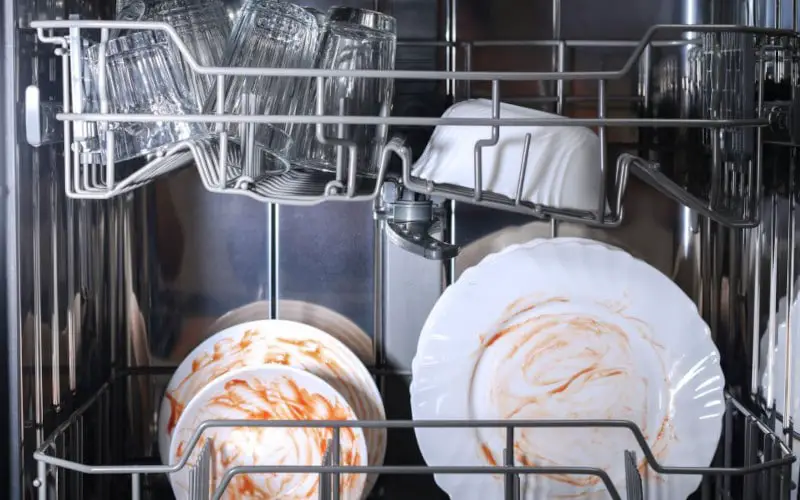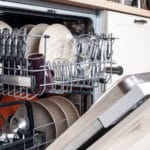Drying is an essential final step in a dishwasher’s wash cycle, even though the device’s main purpose is to clean dishes. When your Whirlpool dishwasher leaves items wet after the cycle is finished, we frequently realize its importance.
We’ll look at typical causes for this issue, such as overloaded racks or incorrect settings, as well as some lesser-known potential causes.
Solution 1: Overloaded Rack
An overloaded rack is one of the most common reasons a dishwasher doesn’t dry properly. When dishes are crammed in too tightly, they can block the circulation of hot air, which is necessary for drying.
Make sure to leave enough space between items on the racks so that hot air can circulate freely.
Solution 2: Incorrect Settings
Another common reason for dishes not to dry properly is incorrect settings. If you have your dishwasher set to air dry or energy saver mode, your dishes won’t come out completely dry.
Instead, use the normal or heavy-duty cycle and make sure the heated dry option is selected.
Solution 3: Defective Heating Element
If your dishwasher is not drying dishes correctly, even when the settings are correct, the heating element may be defective. This component is responsible for generating the hot air that dries the dishes, so if it’s not working properly, the dishes will not dry.
To test the heating element, use a multimeter to test for continuity. If the reading is infinite, the heating element is defective and will need to be replaced.
Solution 4: Defective Thermostat
The thermostat monitors the dishwasher’s water temperature and ensures it gets hot enough to clean the dishes properly. If it’s not working properly, the dishes may not get hot enough to dry.
To test the thermostat, use a multimeter to test for continuity. If the reading is infinite, the thermostat is defective and will need to be replaced.
Solution 5: Clogged Vent
The vent allows hot air to escape from the dishwasher; if it’s clogged, the air will have nowhere to go. This can cause the dishwasher to overheat and shut off or prevent the dishes from drying properly.
To clean the vent, remove the access panel and use a vacuum cleaner with a hose attachment to remove any debris that may be blocking the vent.
Solution 6: Vent
The vents in your dishwasher may not be opening properly. Many dishwashers utilize a vent to release the hot, steamy air created during the rinse cycle while the dishes are drying.
If the vent does not work properly, moisture will accumulate on the plates. Make sure that the vent is operating as intended.
Solution 7: Vent Fan Motor
A vent fan motor is used in some dishwashers to help dry the dishes at the end of the cycle. The dishwasher won’t dry the plates properly if the fan motor isn’t operating. Check for continuity on the fan motor to see if it’s failed.
Also, manually turn the fan blade to make sure it spins freely. If the motor is defective, it will need to be replaced.
Solution 8: Heating Element Relay
The heating element relay is a switch that turns the heating element on and off. If the relay is defective, the heating element will not turn on, and the dishes will not dry. Check for continuity on the heating element relay to see if it’s failed.
Solution 9: Float Switch
The float switch is a safety device that turns the dishwasher off if the water level gets too high. If the float switch is defective, the dishwasher may not turn on, or it may not fill with water properly.
To test the float switch, use a multimeter to test for continuity. If the reading is infinite, the float switch is defective and will need to be replaced.
Solution 10: Timer
The timer regulates the voltage to the heating element circuit. If a timer fails, certain components may not operate correctly. Timers are often misdiagnosed.
Start by testing more commonly defective components before replacing the timer.
Solution 11: Temperature Sensor
The temperature sensor monitors the water temperature and tells the dishwasher when to turn on the heating element. If the sensor is not working properly, the heating element may not turn on, or the dishes may not get hot enough to dry.
To test the temperature sensor, use a multimeter to test for continuity. If the reading is infinite, the temperature sensor is defective and will need to be replaced.
Solution 12: Control Board
The control board controls the heating element circuit’s voltage. If the control board fails, some components will not operate correctly. Control boards are frequently misinterpreted.
Before replacing the control board, check for more commonly defective components first.
Frequently Asked Questions
Why Are My Dishes Still Wet After Dishwasher?
If your dishwasher is leaving dishes wet, there are several possible causes. First, check to make sure that the dishwasher is draining properly. If the dishwasher isn’t draining, water will remain in the tub and can cause the dishes to come out wet.
Another possibility is that the heating element isn’t working properly. The heating element helps to dry the dishes, so if it’s not working, the dishes may come out wet.
Finally, make sure that the vent is clear and unobstructed. If the vent is blocked, the hot air can’t escape, and the dishes won’t dry properly.
How Do I Fix a Dishwasher That Won’t Fill With Water?
If your dishwasher doesn’t fill with water, there are a few possible causes. First, check the float switch to make sure it’s not stuck in the “off” position. The float switch is a safety device that turns the dishwasher off if the water level gets too high.
The float switch may not turn the dishwasher on if it is defective. Another possibility is that the inlet valve is defective and isn’t opening to let water into the dishwasher.
Finally, check the control board to ensure it sends voltage to the inlet valve. If the control board is defective, it may not send voltage to the inlet valve, preventing it from opening.
How Do I Fix a Dishwasher That Won’t Start?
There are several possible reasons why your dishwasher won’t start. First, make sure that the door is closed all the way and that the latch is engaged. If the door isn’t closed or the latch isn’t engaged, the dishwasher won’t start.
Another possibility is that the float switch is stuck in the “off” position. The float switch is a safety device that turns the dishwasher off if the water level gets too high. The float switch may not turn the dishwasher on if it is defective.
Finally, check the control board to make sure it’s sending voltage to the door latch switch. If the control board is defective, it may not send voltage to the door latch switch, preventing the dishwasher from starting.
How Do I Fix a Dishwasher That Won’t Stop Running?
If your dishwasher doesn’t stop running, there are several possible causes. First, check the float switch to make sure it’s not stuck in the “on” position. The float switch is a safety device that turns the dishwasher off if the water level gets too high.
The float switch may not turn the dishwasher off if it is defective. Another possibility is that the control board is defective and isn’t sending a signal to the pump to turn off.
Finally, make sure that the door is closed all the way and that the latch is engaged. If the door isn’t closed or the latch isn’t engaged, the dishwasher will continue to run.
How Do I Fix a Dishwasher That Leaks Water?
If your dishwasher leaks water, there are several possible causes. First, check the gasket around the door to make sure it’s not damaged or warped. If the gasket is damaged, it may not seal properly, and water can leak.
Another possibility is that the float switch is stuck in the “on” position. The float switch is a safety device that turns the dishwasher off if the water level gets too high. If the float switch is defective, it may not turn the dishwasher off, causing it to leak water.
Finally, check the hose that connects the dishwasher to the water supply. If the hose is cracked or damaged, it may leak water.
How Do I Fix a Dishwasher That Won’t Drain?
There are a variety of reasons why your dishwasher might not drain. First, check the hose that connects the dishwasher to the drain. If the hose is kinked or clogged, it may prevent water from draining.
Another possibility is that the pump is defective and isn’t able to pump water out of the dishwasher. Finally, make sure that the float switch is in the “off” position. The float switch is a safety device that turns the dishwasher off if the water level gets too high.
If the float switch is defective, it may not turn the dishwasher off, causing it to overflow and preventing the water from draining.
How Do I Fix a Dishwasher That Won’t Dispense Detergent?
If your dishwasher doesn’t dispense detergent, there are several possible causes. First, check the detergent dispenser to make sure it’s not clogged. If the dispenser is clogged, detergent can’t flow through it.
Another possibility is that the defective control board isn’t sending a signal to the dispenser to open. Finally, make sure that the detergent dispenser is filled with detergent. If the dispenser is empty, it can’t dispense detergent.
How Do I Fix a Dishwasher That Runs Too Long?
There are several reasons why your dishwasher might run for an excessively long amount of time. First, check the water temperature. If the water is too cold, it can take longer for the dishwasher to wash the dishes.
Another possibility is that the float switch is stuck in the “on” position. The float switch is a safety device that turns the dishwasher off if the water level gets too high. If the float switch is defective, it may not turn the dishwasher off, causing it to run for too long.
Finally, make sure that the door is closed all the way and that the latch is engaged. If the door isn’t closed or the latch isn’t engaged, the dishwasher will continue to run.
Conclusion
If your Whirlpool dishwasher is still not drying dishes correctly after trying these solutions, you may need to call a technician for further assistance.






